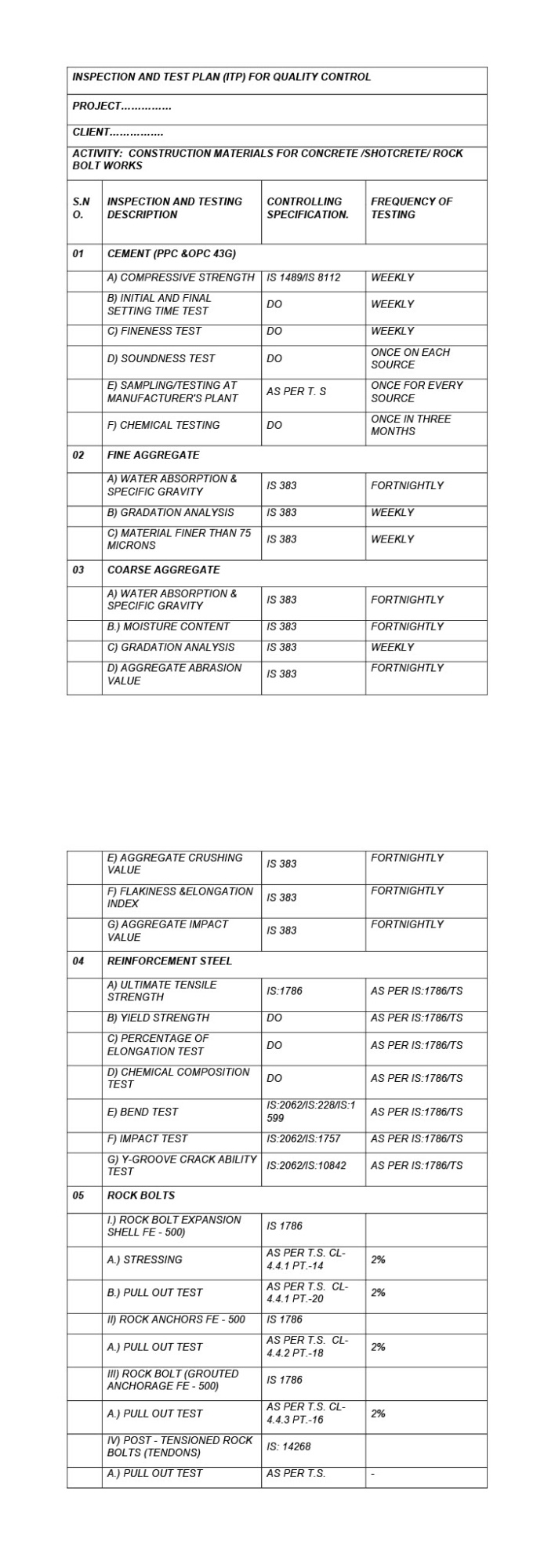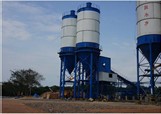
What to Check for Optimal Performance of Concrete Batching Plant (BP) and Aggregate Processing Plant (CP) Operations are mentioned in this blog. The blog describes the activities involved at the plants in reference to the quality aspects and suggest some guidance and checklist, which if implemented shall assure the quality of concrete ingredients. Quality Control Assurance.
ASTM American Society for Testing and Materials
BP Batching Plant
PP Processing Plant
CP Crushing Plant
RBM River Bed Material
FA Fine Aggregate
CA Coarse Aggregate
ITP Inspection and Test Plan
QC Quality Control
QA Quality Assurance
CONTENTS
General
Types of Concrete
Coarse Aggregates Grading
Guidance for Crushing (PP / CP) and Batching Plant Operations
Temperature Management
Slump measurements
Fine Aggregates
Coarse Aggregates
Role of Staff at Workplace
Document Management
QAQC Checklist for operation of Crushing Plant and Batching Plant
General
Concrete basically is obtained by mixing Cement, Fine Aggregates (FA), Coarse Aggregates (CA) and Water in designed proportions. The quality of concrete is further upgraded by use of mineral and chemical admixtures.
CA and FA are either obtained from River Bed Material (RBM) or Rocks. In both cases, processing / crushing plants (PP / CP) are used. The bigger rock or boulder are crushed in crusher and after washing are transferred by conveyer belts to screens of required sizes / different sizes (general from 80 mm to 4.75 mm size) and thereafter collected at the site bins.

The material finer than 4.75 mm is further washed and processed by classifier to get FA of required specification.
The FA and CA thus obtained are used in manufacture of concrete at the Batching Plant (BP). The processed FA and CA are transported to BP either by carriers or by belt conveyers. The concrete ingredients once available at BP, are used by mixing them in desired proportions in concrete mixer of BP. The concrete so obtained is transported to the site of work by different conveyance means.
The quality of concrete depends on the quality of concrete ingredients. The CA and FA material sources (raw material) are checked for the quality of materials, before the raw material is brought to PP.
The main purpose at PP is to get the FA and CA in design. The output of FA and CA, therefore, is managed at the plant operation level and necessary corrections are applied at site to get the right things.AS such the PP operations must be checked regularly with the help of checklist. (Checklist is a well-used quality tool). Similarly, the BP operations are checked as per checklist. Generally, these checklists are of generic nature, but they are further upgraded as per work need and as per requirement of specifications of the works.

Grading of Aggregates

Please refer details of concrete at the following link for different types of concrete:
https://www.techpostsk.com/2021/09/different-types-of-concrete.html

Topics Covered in Different Types of Concrete
General
Types of Concrete – Nominal Mix Concrete
Types of Concrete -Design Mix Concrete
Data Required for Design Mix Concrete
Brief description for types of concrete
Summary of Different types of Concrete
Project Concrete Requirements Management
Guidance for Crushing (PP / CP) and Batching Plant Operations:
An Inspection and test plan for overall work is prepared first. This plan contains following information:
Inspection and Testing Description
Controlling Specification in reference to Code
Frequency of Testing
The ITP is shown below and may be updated as per requirement of works. (The items related to FA and CA may be referred for understanding on reference to the current subject matter.

Raw material for aggregates should be from approved quarry site

Temperature management
Temperature management at Processing Plant and Batching Plant for FA and CA must be carried out for temperature variations and necessary temperature control methods must be used. Some of the temperature control methods include shading of FA and CA arrangement at CP / PP / BP.



Slump measurements
Slump measurements at Batching Plant site should be carried for manufactured concrete in specified volume. This is done to ensure that the concrete production is as per required specifications
Supervision of mix ingredients at BP must be recorded. (With the use of Computerized System)
SLUMP OF CEMENT CONCRETE/CUBE CASTING

The fine aggregates are taken from CP with size 0~4.75mm. The testing is performed using standard ASTM C33. The test results for fine aggregate are shown below as an example.
| Sieve Size (mm) | Specification | Test Result –Pass percentage |
| ASTM C33 | Crushing plant sample | |
| 9.5 | 100 | 100 |
| 4.75 | 95~100 | 99.2 |
| 2.36 | 80~100 | 83.2 |
| 1.18 | 50~85 | 62.6 |
| 0.60 | 25~60 | 42.2 |
| 0.30 | 5~30 | 26.4 |
| 0.15 | 0~10 | 17.0 |
| 0.075 | 0~5 | 8.3 |
| Rock Powder | 2.3~3.1 | 17.0 |

The results obtained need to be reviewed and approved for use by control engineer.
Aggregates are categorized in sizes 2.36-9.5, 4.75-19.0, 19.0-37.5, and 37.5-75mm. Examples, in reference to ASTM C 33 are shown below for test sample. If the aggregate size does not conform then they are adjusted for oversize and undersize , to some extent. The screens of the plants and crushing systems are corrected for proper output.
Coarse Aggregate Test Results
Grading Results of Coarse Aggregate (37.5-75mm)

Grading Results of Coarse Aggregate (4.75-19mm)

The aggregates are also tested for attributes given below in reference to ASTM C 33

Trip cards are used at batching plant and contains the production mix details, carrier details and site detail .
Role of Staff at Workplace
The role of the personnel at the batching plant includes the following, but not limited to:
- Sampling of cement, sand (FA), and coarse aggregates (CA). The samples are taken to the laboratory for testing as per ITP.
- Testing moisture content for the fine aggregates, and coarse aggregates.
- Testing slump at batching plant and placing point.
- Casting concrete cubes for permanent and temporary works.
- Checking the temperature of concrete and air, at batching plant and site.
- Inspecting the quality of materials used in concrete mixing.
- Checking the temperature of the fine aggregates and coarse aggregates from the stockpile.
- Checking the quality of concrete at the mixing point and at placing point.
- Taking records of the quantities required per mix design.
- Making necessary adjustments in concrete mixing depending on the fineness modulus of sand aggregates.
- Taking record of all the concrete casted, both permanent and temporary concrete.
- Making a daily report of the activities done at the batching plant.
- Monitoring the usage and quantity of the admixture at the batching plant.
- Ensuring that the mix designs and mix proportion test of the concrete is done correctly at the batching plant.
Document Management
The documenting of all the QC records is done at the laboratory. These records include those from the batching plant, site, and laboratory. The records are kept both in a computerised way and filing of the hard copies.
The records kept include the following.
- Test records on cement.
- Test records on aggregates.
- Test records on chemical admixtures.
- Test records on fly ash and other mineral admixtures
- Records of materials delivered on site.
- All other records related to QC of concrete materials.
- Such as Inspection request / Okey cards, pour cards, Trip cards, aggregate size adjustments, moisture measurement and adjustment and other records related to BP and PP / CP operations in reference to Quality Assurance and Quality Controls.
QAQC CHECKLIST CRUSHING and batching plant Check List (Indicative)
Important points for materials at Crushing and Batching Plants, but not limited to are mentioned in the checklist

In reference to quality aspects, the post contents may be used to have necessary checks so that all materials of good quality is always available at site. The controls discussed above, if applied earnestly, fulfill the requirement of good concrete production , to a great extent and assure that a good quality of concrete is delivered to siteof work .
In case if the results of tests do not conform to standards and specifications,the concrete production must be stopped and such information should be sent immediately to higher management to take up corrective measures.


